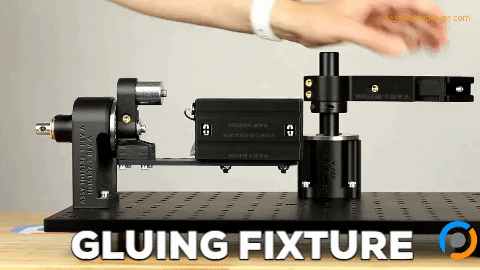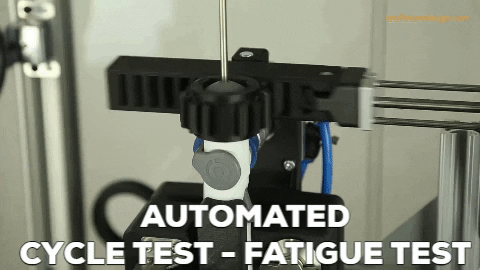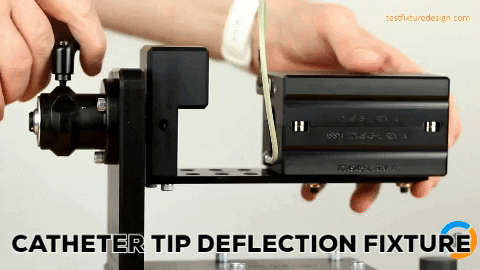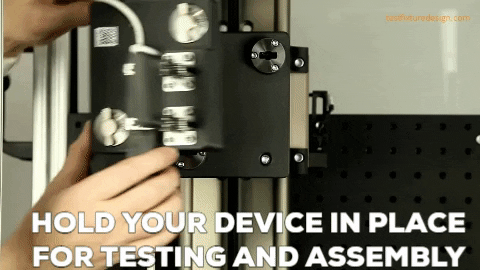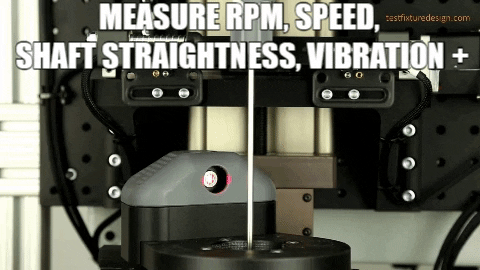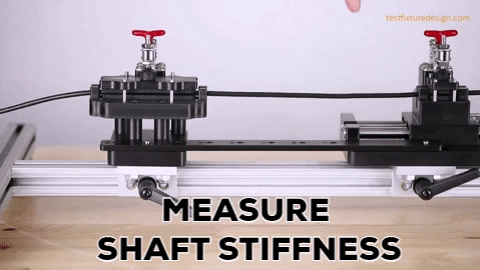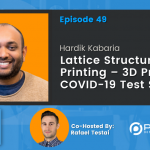Sean McEligot | Medical Device Research & Development at Mayo Clinic
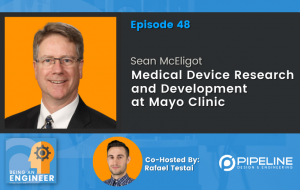
Who is Sean McEligot?
In this episode, Sean McEligot discusses what it’s like working at the Mayo Clinic’s engineering department. In addition, we also talk about what the Mayo Clinic looks for in engineers they hire.
Sean McEligot is Section Head in the Division of Engineering and Quality Manager. Meanwhile, Sean has second-line managerial responsibility for the Applied Computational Engineering Unit, the Biomechanical Development Unit, and the Biomechanical Shop. He is the Director of the Mayo Clinic Division of Engineering Additive Manufacturing Facility and oversees the Division of Engineering Microfabrication Facility.
Sean graduated with BS in mechanical engineering from Stanford University and a Masters of Healthcare Administration from the University of Minnesota.
EXPAND TO VIEW EPISODE TRANSCRIPTION
SUMMARY KEYWORDS
mayo clinic, design, surgeons, working, patient, engineer, implants, engineering, printing, medical device, people, additive manufacturing, 3d printing, models, anatomy, mechanical engineering, radiologist, surgery, division, fruit flies
SPEAKERS
Sean Mceligot, Aaron Moncur, Presenter, Rafael Testai
Presenter 00:00
The being an engineer podcast is a repository for industry knowledge and a tool through which engineers learn about and connect with relevant companies, technologies, people, resources and opportunities. Enjoy the show.
Rafael Testai 00:29
Hello, everyone, welcome to the being an engineer Podcast with your co host, Rafael Testai. Today I’ve got a very special guest, Sean McEligot. He’s the section head of medical device research and development at none other than the Mayo Clinic. So he does the quality, he’s a quality manager. He has a second line managerial responsibility for the applied computational engineering unit, the biomechanical development unit, and the biomechanical shop. He’s the director of the Mayo Clinic division of engineering additive manufacturing facility and oversees the division of engineering micro fabrication facility. He has a bachelor’s in mechanical engineering from Stanford University, and a Master’s of healthcare administration from the University of Minnesota. Sean, welcome to the show.
Sean Mceligot 01:26
Thank you. I’m glad to be here. Well, thanks.
Rafael Testai 01:29
So we first heard about you, and an article in the magazine, machine design magazine. And the article is titled How to make medical organizations use additive manufacturing. And the link is in the show notes for our listeners. But many of our listeners are driving right now. And they can’t read the article. So would you mind maybe summarizing what the article is about?
Sean Mceligot 01:56
I guess I can’t, I can’t necessarily summarize that particular article, because I don’t have it top of mind. But I will say that, you know, different medical institutions use additive manufacturing differently. If you look at the Veterans Affairs Administration, with Dr. Beth Ripley leading their 3d printing effort, they are doing completely different things than the Mayo Clinic division of engineering does. But so they’re doing some of them are the same, and some are different. I’m personally within the Mayo Clinic division of engineering. So we are doing medical device development and instrument design, and laboratory instruments as well. And so we’re using it for prototyping for show Intel product types, functional prototypes for working parts as well. And so the full full gamut there, where we have another partner organization over in the Department of Radiology, that is using 3d printing to do pre surgical to print pre surgical planning models for surgeons to see the anatomy before they do surgery. That’s really taking the country by storm and is probably the prime premiere primary use of 3d printing in hospitals.
Rafael Testai 03:23
Can I want to ask you something? So you mentioned that other hospitals, not the Mayo Clinic are primarily using 3d printing to print the patient’s anatomy. Is that right?
Sean Mceligot 03:34
Yes, that that’s becoming more and more common. The radiological Society of North America has a special interest group on 3d printing. And so it’s mostly great practice practicing radiologists that are involved in running the 3d printing labs or biomedical engineers that are associated with them. And I don’t know their exact membership, but there are, are probably hundreds of people now involved in 3d printing in hospitals, primarily for looking at the patient anatomy. So radiologists can see the images, you know, they’re, they’re trained, they’re there. They’re wired to be able to look at a flat screen and see anatomy surgeons less so surgeons tend to be very tactile and very three dimensional. And so, it we and Mayo Clinic division of engineering got started in 3d printing. When a surgeon a pediatric surgeon went to a radiologist and said, I can’t see this and you have to get me a physical model. And so the radiologist, Dr. Chang Matsumoto came to division of engineering among others, and came up with the first 3d models that were used significantly within Mayo Clinic and it was for a pair of conjoined twins, that they were doing a separation surgery and is very simple wasn’t that they figured out the twins shared a liver, it was very important that they figure out where to cut that liver to make sure that each twin got their share of the liver. Ultimately, they they, they said that the 3d printed models were perfect. They showed them exactly where to cut, they actually one of the surgeons took his Sharpie out and marked on the model, this is where we’re going to cut, we pulled when he opened up the patients, that was the liver was as it appeared. And he cut it where he had planned to and and was That was back in 2006. And the patients are still alive and doing well. And so it was a phenomenal success. And that was our, our entry into 3d printing at Mayo Clinic.
Rafael Testai 05:46
Wow, what a beautifully told story. And so many threads of conversation just opened up, I was gonna ask you, let’s see, well, what comes to mind is, how do you gather their scan data? What do you use for that
Sean Mceligot 06:02
the scan data typically comes from a CT scanner, or an MRI, the easiest to do is bone it’s it’s easiest to get the to recognize the contrast difference between the bone and the soft tissue. But soft tissue anatomy can also be imaged. And so there is there are open source and a variety of different software packages out there that take the imaging output, typically a format file format is DICOM. Take a DICOM file of slices of CT scan, and then assemble them into a whole segment out the anatomy from that data and then it it basically gets turned into a shell, you can then turn it into an STL file from the from the output from the software.
Rafael Testai 07:01
Okay, and then my follow up question was, I could I’ve never seen maybe an organ of a human being in person, but from what I gather is somewhere of viscosity, viscosity like Oregon’s inside your stomach and your body can move around a little bit if you Suck in your stomach, etc. If you twist your abdomen if you’re exercising, so when you tell me that the the insides deliver was 3d printed, and then when they did the surgery, it looked exactly the same. In my mind, I thought it was a little strange, because I would think that the liver may have moved a little bit. Is it this exactly the same? Or does it make sense? What I’m asking?
Sean Mceligot 07:42
Yeah, does the liver the the, you know, think about the I guess the meats that you would buy at the deli counter right? Liver is moves, but if it’s surrounded by tissue, it’s going to it doesn’t have anywhere to move where the stomach the you know, the the intestines and whatnot, they are they they are designed to move around, you know, the liver and kidneys are are not rigid objects but but they pretty much maintain their shape.
Rafael Testai 08:17
Understood. So let’s see, if one is going to have an invasive procedure to let’s say a remove a tumor, and sometimes the surgeons, it would be advantageous for them to get some practice on a 3d printed model before they go inside your inside one of your loved ones can one request that Mayo clinic or hospital if we pay a little bit more to maybe have the surgeons practice on a 3d print before our loved one. You know,
Sean Mceligot 08:47
practicing on the on the 3d printed model doesn’t really work because the material properties are different. So they’re they’re really showing tell they allow the surgeons to see what they wouldn’t otherwise be able to see. But they really wind up being visual models rather than functional models. But and so one key point there is that the surgeons will come to you know, we’ve we division of engineering helped get the process started at Mayo Clinic, but ultimately handed it off to the Department of Radiology that has an anatomical modeling unit in the Department of Radiology. So they have the biomedical engineers working directly with the radiologist to create the these planning models. And so, you know, they really are just, you know, visual models for the surgeons to plan but, and for most surgeries, the surgeons know exactly what they’re going to see you know for a hip replacement or a knee replacement, a typical and Anatomy, they know what they’re gonna see they go in, they do the work, as far as you know, but, you know, I think an awful lot of the anatomical models are used for cancer treatment for resecting tumors. And for the surgeons to, especially where it’s a very complex tumor, they where they have to avoid critical anatomy, then they’ll be able to look at it and actually plan their surgery very exactly to figure out where they’re going to, where they’re going to enter where they’re going to cut and how they’re going to get the tumor they need.
Rafael Testai 10:38
Understood. So in your description of 3d printing, you mentioned that it is also used for laboratory instruments. May I ask what kind?
Sean Mceligot 10:48
Well, so the division of engineering or a group of 70 people, Mayo Clinic is a company or an institution rather, of 70,000 people were 70 people within that organization, engineers, mechanical engineers, software engineers, electrical engineers, project managers, managers, machinists technicians, and we do we design and build one of a kind of medical devices and laboratory instruments for Mayo Clinic, we’re doing one of a kind one off, if if our volumes get over, you know, 10 to 30, we will automatically send it outside for somebody else to make it because our skill, our focus is on the one of a kind. And so the laboratory instruments that we would be using 3d printing for it, 3d printing actually lends itself to what we do relatively well, better than it would for industry, because we’re only making one or two, you know, if, if you’re making 10,000 of something, it makes sense to buy a, an injection molded and molded parts out of plastic or to to use higher technology manufacturing, more investment, higher investment levels of manufacturing. For us, we’re doing one or two. So it makes sense to, to do things as quickly and and easily as possible, while recognizing worth it within the hospital environment. And we certainly have to pay attention to safety and quality.
Rafael Testai 12:31
I see. I was going to ask you this, but maybe I can answer my own question which was going to be Why would one want to build a one of a kind lab instrument? And I think the answer is because so is patient specific. Right?
Sean Mceligot 12:45
Well, so we’re talking about laboratory instruments, as opposed to surgical instruments or medical devices for laboratory instruments. Mayo Clinic is a huge research organization doing mostly translate translational medicine, less on the basic science and more, how can we take things that have already been understood and translate them into medical practice? One example of a, one of my favorite examples of a laboratory instrument that the division made was a flight counter for counting fruit flies, the standard of practice was to count 10 or so fruit flies into a vial. And then they would, the idea here is that fruit flies, they’re looking at the neural function of the fruit flies, and whether they’re affected by chemotherapeutic agents or anesthetics. And so it’s a laboratory work where they’ll put the fruit flies in, they’ll tap the vial down and see how quickly they fruit flies naturally climb, see how quickly they climb the side of the of the vial, and with a stopwatch and, and measure their performance. Then they’ll introduce the agent that they’re interested in studying, and do it again and see how much the fruit flies have been affected by the agent that was introduced. So very, very labor intensive. We, they came to division of engineering and we designed to devise a system that could count the fruit flies rather than do manually counting them. We were doing image recognition. So we take digital imaging, and then run digital analysis to automatically count the fruit flies, we would be able to do instead of just doing one vial at a time, we could do 10 vials at a time and tap them all down. Allow them to the fruit flies declined for a prescribed amount of time and then take another picture and count the fruit flies. And instead of having 10 in a vial, we could have 50 in a vial so We went from one, lab tech being able to test 10 fruit flies at a time to one lab tech being able to test 500 fruit flies at a time. So it was a tremendous expansion of the of the capabilities that lab. But ask how many institutions in the country need an automated fruit fly counter? There aren’t that many. So that’s why we you know, why we do one of a kind laboratory instruments.
Rafael Testai 15:32
Okay, so thank you for story. So this is happening, not the fruit fly. But the the two twins that were separated, this happened in 2006. So where are we now in terms of 3d printing.
Sean Mceligot 15:45
So we went from those first conjoined twins, we didn’t own a 3d printer at the time, we, we we wound up working with an imaging laboratory at at Mayo to develop the STL models, which we then sent out to a lab up in the Twin Cities in Minneapolis, St. Paul area to get prints done for us of old fashioned STL. stereo lithography. So fairly early on in in the whole evolution of 3d printing, we very quickly realized that there was a place for us to own one. So we bought our first 3d printer, which was a mid priced at the time, I guess mid priced, fused filament fabrication, 3d printers, sort of the classic 3d printers you think of with the plastic filament that gets put through a hot nozzle and then laid down on a on a platform. We use that one for for a number of years, and then expanded into a variety of other different 3d printers. So in the Division of engineering, where we’re not using it as much for anatomy anymore, but using it more for using the 3d printers more for, for prototypes. And for working parts, we now have two different or three different fused filament fabrication versions, we have a Multi Jet Fusion, polymer, nylon powder printer, and we have a couple of different stereo lithography systems of different sizes. And our our crowning achievement is we have a selective laser melting metal printer that we have full of implant grade titanium that we’re working to use, working towards being able to do to 3d print patient specific implants for use in the clinic.
Rafael Testai 18:04
This reminds me of maybe I watched a show on Netflix or something like that, that it was about the medical field and how when if one wants to get maybe a knee replacement, you only have like three sizes, small, medium, large, and a lot of patients don’t fit that. And this will be revolutionary in the sense that you could replace the knee maybe with a specific knee that fits the patient. Am I Am I right on that?
Sean Mceligot 18:30
Well, yes, although as far as knees go there, I think at this point there is a reasonable supply or reasonable selection of knees. And so what where we live, as I said, we do one of a kind. And so knees, a new knee, knee replacements, hip replacements, shoulder replacements, even spinal vertebral segments and, and spinal plates. All these things are commercial there. They’re readily available. They’re being mass produced by some very, very successful implant manufacturers. And so there isn’t that much room for for us to innovate on a on a one of a kind basis because chances are really good that the surgeon is going to be able to find a knee that will work for them that a hip that will work for him a shoulder that will work for him. Where we have found some success in you know, not so much the patient specific side but in the prototyping side is we’ve started working with surgeons general, a lot of them being orthopedic surgeons that have ideas about better implants. So Dr. Sperling is is a shoulder surgeon who has multiple patents and has come up with you has some great ideas for improving the implants that he’s using in his practice. But as I said, we’re one of a kind, we’re not going to make large volumes for so his best way of being able to buy the part that he wants that he designed, is to work with us to reduce his his idea to practice to take it to prototype, and then take it into to Cat cadaver studies, and then patent it and license it to a medical device manufacturer so that they can commercialize it, and then sell it to him. And it winds up being win win win. And we wind up helping him realize, you know, helping him improve the practice of medicine in his patient population.
Rafael Testai 20:48
The one thing that I don’t understand is if there are already companies that are very successful at providing the needs that the hips what are we what are we using the titanium custom one off parts for to replace what parts in the body.
Sean Mceligot 21:04
So the the first part we’re looking at is mandible, plating. So it’s anytime there’s a lot of patient variation, you know, you think about the mandible, the jaw, everybody’s jaw is shaped differently. Now, male has a fairly large practice, a couple 100 cases a year of tumors in the jaw in the mandible that have to be resected that have to be removed. And the right now the Department of Radiology, the anatomical modeling unit, will take images of will take the images will create 3d models, they’ll sit down with the surgeon and do pre surgical virtual surgical planning to decide where they’re going to cut the bone to resect the tumor, they’ll also do they use the the fibula has a spare piece of bone. And so they will take a section of the patient’s fibula, there, they’re the smaller and narrower shin bone and, and they will cut it and to fit into the the end of the jaw. And then they’ll use a plate to hold all of the pieces together to hold the remaining job pieces together and the and the the filler the the replacement bone holding everything together and in alignment. And it’s really just a plating version, it’s not providing long term strength or structure. But it’s it’s it’s allowing the bones to fuse and to grow and to heal in proper alignment. Now, they can use stock plates for that. And sometimes if they’re if time is critical, they’ll even take a case where they would prefer to use a patient’s specific plate and they will actually bend it in the bill, they’ll use a stock plate and they’ll bend it in the operating room to fit. Well that’s not optimal. What’s best is, you know to getting, you know designing in advance a custom plate. There are companies that do this, that we can go outside and purchase these patient specific implants. We believe that we can cut the timeline down so that it meets Mayo Clinic’s needs. Mayo Clinic isn’t the best Destination Medical Center. So people come here to Mayo Clinic to or whether it’s the, you know, the original Mayo Clinic in Rochester, Minnesota or one of the other destination centers in Phoenix or Jacksonville. People travel to visit Mayo Clinic. And so the the sort of the ideal, the perfect the perfect case model of care is the patient shows up on Monday for some some testing. They see specialists on on Monday or Tuesday they get diagnosed a course of treatment is defined. And by Thursday or Friday they’re in surgery. Now, the current standard of care for patient specific implants, the timeline doesn’t support that. We believe that we can take that within five days, the patient can be imaged the anatomical modeling unit and radiology can do their virtual surgical planning and can provide us with the requirements for what they need in an implant. We would design that implant, print it post process it and deliver it to sterilization suitable for surgery on Friday.
Rafael Testai 24:49
That’s a great value proposition for for a patient. quick turnaround. Yeah, okay. I wanted to take a quick moment to mention that there being an engineer Pog AST is brought to you by pipeline design and engineering, located here in Phoenix, Arizona, pipeline partners where medical and other device medical device engineering teams could a turnkey equipment such as cycle test machines, custom test fixtures, automation equipment, assembly jigs, inspection stations and more. You can find us on the web at Teampipeline.us. Now I’m here with Sean McEligot. And I was telling Sean asked him before the interview started, if he could tell me how to pronounce his name, and he told me that if you pronounce every letter on his name, you’re good. And then I mentioned that I’m bilingual in Spanish, so it’s not an issue for me. So I wanted to talk to you about all the things that you do at Mayo Clinic, it says that you are involved in the applied computational engineering unit, the biomechanical development unit, the biomechanical shop, the engineering edit out additive manufacturing facility, and the engineering microfabrication. facility. It sounds like you’re five people into one, how really like how do you manage all these moving parts?
Sean Mceligot 26:10
A key part of it is having good people working with you. And so I’m director of the additive manufacturing facility, but we have a unit manager over the mechanical engineering unit, and, and the additive manufacturing staff for the additive manufacturing facility report to her in talking about doing patient specific implants. I’m, I’m participating that I’m the management sponsor, but we have a project manager who is tasked with that, and we’ve got a team of six or eight who are, are actively working on that. So it really is a matter of being able to, to have great people working for you and, you know, empowering them to do their work.
Rafael Testai 26:57
Absolutely. Well, this is a perfect segue, because you mentioned that the Mayo Clinic is the destination for a quick turnaround and some of the best treatment in the entire world. So I can imagine, this is probably not a question that you get that you get often asked on podcast. But if I’m in your shoes, and I’m working my way up as an engineer, and I apply to the Mayo Clinic, and I get hired, what was the moment like when you got the call from the Mayo Clinic telling you that you were hired.
Sean Mceligot 27:29
It was great, although I’m not sure that I really realized how lucky I was and how much I loved being at the Mayo Clinic, you know, right away. Because, you know, before I was at the Mayo Clinic, I was at, I was working in industry in the medical device industry as a medical device, design engineer and project manager and manager. And, you know, in working in the device industry, or in industry, in general, I think you so often you get onto one product line, you know, that product line, you you, you know, next year, I’m going to be designing a smaller one of these or a bigger one of these, or a dual version of this or a plastic or a titanium. And so it you can really see the writing on the wall, you know, years and years in the future. Where Mayo Clinic, as I said, we’re doing one of a kind medical devices and laboratory instruments. And, and at any time with among our 70 people, we have 30 projects going on. And, and so it really is a matter of, of being able to, to, you know, not getting stuck in a rut, but being able to find, you know, to help in many, many different ways. Another aspect of working at Mayo Clinic was that, again, being out in the medical device industry, it’s a challenge to get input from doctors, and it’s a challenge to be able to see products in use. And working within the Mayo Clinic we are and we’re Mayo Clinic employees, we are already covered by the informed consent that the patients sign. So if we’re working with a surgeon, and we need to observe a surgery, it’s simply a matter of the surgeon calling up nursing and say, you know, help this engineer get into the operating room for me. And, and so it’s it’s really it’s wonderful in that regard. And as far as getting, you know, doctors input, again, in your medical device industry, you go to conferences, you try to get time with doctors, you paid doctors to talk to you in working at the Mayo Clinic. They’re coming and asking for our help for asking us to help them and so it really is, you know, they have to they have time that we’re helping them get achieve what they want to achieve.
Rafael Testai 29:56
When you mentioned that the engineers were already covered by the patient consent, what’s the exact term, informed consent, informed consent and how it removes all these barriers and allows engineers to be present in the surgery. It reminds me of a core value here a pipeline that’s called governed by productivity and not bureaucracy. So it’s like all that red tape is gone, and you just get your hands, you can go to work and get the information you need. So I think that’s pretty cool. On the other side, let’s say that there are engineers interested in helping the Mayo Clinic’s vision, what are some things that the Mayo Clinic may look for in the engineers that they hire?
Sean Mceligot 30:41
We Well, the key thing is, is skill, expertise, knowledge in the discipline that they’ve been trained in. And so for the mechanical engineers, I am now second line over the mechanical engineers, I was the first line Mechanical Engineering Manager and hired mechanical engineers. Some of the mechanical engineers are actually biomedical engineers who have who had a strong foundation in mechanical design. But it they’re working at Mayo Clinic, the ideal candidate, is someone who has experience with or experience and interest in the discipline, so mechanical design, electrical design, software design, but also has background and interest in the biology and medical side of things. And so, so yeah, it’s, it’s a special person that is perfect. But there again, you know, my, my training, you know, as you said, at the beginning, I’m, I’m a mechanical engineer, and I have a master’s degree in healthcare administration. Neither one of those teaches you, all this stuff, all the things that one needs to know to be a medical device design engineer. And so some of it is, is on the job and, and a lot of it is working with people that know what they’re doing. And, and then a lot of it is also classes that and seminars and whatnot of learning, you know, they didn’t teach me about the characterization of sterile sterilization, in college. And they didn’t teach me about sterilization validation in college, and they didn’t teach me about biocompatibility in college. But these are all, all things that I’ve had to pick up along the way. And so, you know, we know that the most important thing in hiring somebody is somebody that that that is smart, adaptable, and that cares, you know, that and willing to learn, you know, that it isn’t, you know, we don’t want people that, that feel most comfortable being in a rut, we want people who, who want to learn.
Rafael Testai 32:58
That’s exciting. Let’s see, you mentioned, let’s see that a lot of our listeners are still engineers in college, a lot of them are mechanical, who listen to our podcast. And you mentioned that school is not going to teach you everything, of course, that you need to know in order to maybe contribute at the Mayo Clinic. But there’s time maybe let’s say that there’s a sophomore listening to this right now, what’s something that that sophomore can do to start building that resume or that skill set? So when they graduate, they’re a more attractive applicant for a Mayo Clinic
Sean Mceligot 33:31
with their and I guess, not necessarily just the Mayo Clinic, but the medical device industry in general, I think it would apply to as well. You know, take classes in biomedical. So I would encourage that mechanical engineer to continue and be, you know, graduate as a mechanical engineer. And if they’re interested in design, you know, focus on the design courses in, in, in mechanical engineering, but also take classes in Biomedical Engineering, whether it’s just being able to, you know, just having some background in it or getting a minor or a dual major. We’ve we have one of the engineers that that works in division of engineering has a bachelor’s in mechanical and a master’s in biomedical. And so that’s an option as well. But yeah, so I’d say get get coursework. I think if you’re interested in biomedical, there are biomedical engineering clubs that a lot of our societies and a lot of universities get engaged with that as you’re picking your design projects, pick medical design projects, if they’re available. So that you can can get into that. Look for internships, whether it’s, you know, at the Mayo Clinic we we have internships, but we only have One or two Mechanical Engineering internships. So it’s it’s very selective, but you know, look towards medical device companies and just find whatever internships might might align with with, with your goal of being a medical device design engineer.
Rafael Testai 35:21
Perfect. Is there anything that I should have asked you that I haven’t asked you?
Sean Mceligot 35:27
I can’t think of anything.
Rafael Testai 35:29
Okay. I guess I’ve done a good job in. So how can people reach you?
Sean Mceligot 35:37
I am on LinkedIn. And so I guess I would say, if you’re interested in connecting with me, let me know that you’ve you know, that you’ve heard me on the podcast, and, and express your interest. You know, I don’t, I have financial advisors. So I don’t need more financial advisors trying to connect with me on LinkedIn. But if you’re interested in medical device, if you’re interested in 3d printing, if you’re a college student in mechanical engineering, or any of the engineering disciplines, I’d certainly be happy to be connected on LinkedIn. So you know, just send me a LinkedIn request and we can move from there.
Rafael Testai 36:20
What a beautiful outro. All right, Sean. Well, thank you so much for being on the show.
Sean Mceligot 36:25
Great, thank you.
Aaron Moncur 36:30
I’m Aaron Moncur, founder of pipeline design, and engineering. If you liked what you heard today, please share the episode. To learn how your team can leverage our team’s expertise developing turnkey equipment, custom fixtures and automated machines and with product design, visit us at Team pipeline.us. Thanks for listening
***
We hope you enjoyed this episode of the Being an Engineer Podcast.
Help us rank as the #1 engineering podcast on Apple and Spotify by leaving a review for us.
You can find us under the category: mechanical engineering podcast on Apple Podcasts.
Aaron Moncur and Rafael Testai love hearing from their listeners, so feel free to email us, connect on Facebook, Twitter, Instagram, and subscribe on Apple Podcast and Spotify!
About Being An Engineer
The Being An Engineer podcast is brought to you by Pipeline Design & Engineering. Pipeline partners with medical & other device engineering teams who need turnkey equipment such as cycle test machines, custom test fixtures, automation equipment, assembly jigs, inspection stations, and more. You can find us on the web at www.teampipeline.us.
***
Valued listener, we need your help getting to 100 podcast reviews. Win a $50 Amazon Gift card if you leave us a review on the Apple Podcasts. Simply email a screenshot of your 5-star review to Podcast@teampipeline.us, the email will be in the show notes. We will announce 5 lucky winners at the end of the first quarter in 2022.
You’ve read this far! Therefore, it’s time to turn your headphones up and listen now to this episode to learn all these. Above all, don’t forget to tell your friends who might like this too!





